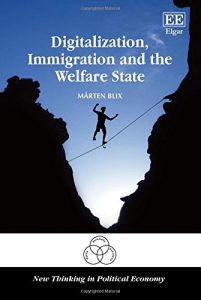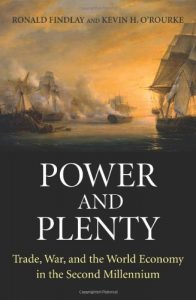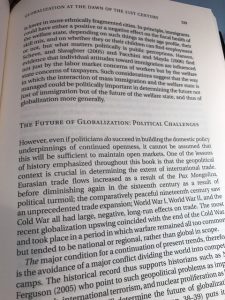Finbarr Livesey’s From Global to Local: The Making of Things and the End of Globalisation is a terrific read, although I’m not completely persuaded by the argument that the transformation of production by global supply chains will be reversed. In fact, the book gives a nuanced and highly informative account of why firms manufacture what they do where they do – making, too, the entirely valid point that the political context is highly uncertain and we could be seeing not only a retreat from hyper-globalisation but a full-blown canter toward nationalism and protectionism. The world has seen such unwindings before.
The first part of the book describes how the increasing specialisation of manufacturing, enabled by technology and declining transaction costs, led to the development of long cross-border supply chains. It then goes on to roll forward the evolution of both transport/transactions costs and automation, covering issues such as containerisation and shipping costs, the oil price, the move to regional trade deals, and agglomeration economies. These are some of my favourite subjects, and these chapters give a very nice synopsis of the economic issues.
However, one of my queries about the argument arises in the section on agglomeration. The suggestion here is that the economic forces of agglomeration apply to cities in developed economies but perhaps not so much in the emerging markets. “One of the open questions is whether the massive collection of companies making so many things in southern China has become a self-reinforcing cluster, a location with its own internal gravity binding manufacturers to it for a significant time into the future. …. [G]iven the rise of automation and the desire of leading firms to retain design and intellectual property control over their products, some of the clustering forces for places like Guangzhou and Shenzhen may not be as strong as thought at first glance.” My guess – no more than that – is that while automation will lead to some ‘reshoring’, as Livesey suggests, the Chinese manufacturing centres do in fact have some distinctive capabilities: the ability to manufacture to consistent standards on a large scale; unparalleled logistical expertise; and growing R&D/design capabilities in a number of products from clothes design to renewables.
Having said that, the book is very strong in describing the complexity of the production decisions facing manufacturers now, and there is loads of interesting detail. One chapter covers environmental issues, including the now widespread drive to reuse and recycle (IKEA is a nice example here). Another looks at trade policy and politics, and the importance of proximity (hello, Brexiteers!), leading some companies to switch their focus from exporting to markets to owning production assets in those markets: “Government regulations on foreign ownership will become the new trade barrier,” as otherwise companies may not be able to access certain markets at all. There is a chapter about automation and additive manufacturing, and the implications of smaller factories, with lower retooling costs, becoming economically viable. Labour costs will become steadily less decisive as a reason for locating production in an emerging economy (although I think that reason has been over-stated sometimes.)
All in all, Livesey predicts: “[I]t is likely we will see anything from a 20-30% fall in global merchandise trade (services are not affected the same way) over the coming decade.” This is quite a bold prediction, implying a big restructuring of production and diminution in importance of cross-border supply chains, given how much of merchandise trade now consists of components rather than finished products. I’m not sure about this, yet do agree with that the technological, political and economic conditions that shaped the world of global supply chains are changing substantially.
From Global to Local makes a great combination read with Richard Baldwin’s The Great Convergence published earlier this year. They offer two different sets of lenses on the organisation of the world of production. One could add Stephen King’s Grave New World, a pessimistic, big picture perspective on global political economy.
Reflecting on these three recent books, they need to be combined with looking at implications for employment and incomes. As David Autor pointed out in his IFS lecture last week, trade has contributed enormously to the biggest decline in poverty recorded in human history as China has grown – and the loss of jobs, income and status among some (not very numerous) groups of people in the west, a narrow but deep cost of technology & globalisation. We surely need to think much harder about the social and economic welfare implications of current trends, including whose welfare, given how badly prepared economists and politicans were for the implications of past developments. Globalisation and automation started to eat western livelihoods around 1980, and the failure to make sure those who lost out were properly compensated with appropriate policies goes quite a long way to explain today’s politics.
[amazon_link asins=’1781256594,067466048X,0300218044′ template=’ProductAd’ store=’enlighteconom-21′ marketplace=’UK’ link_id=’3c3db0ff-5993-11e7-ae93-dd4a39e89aff’]




